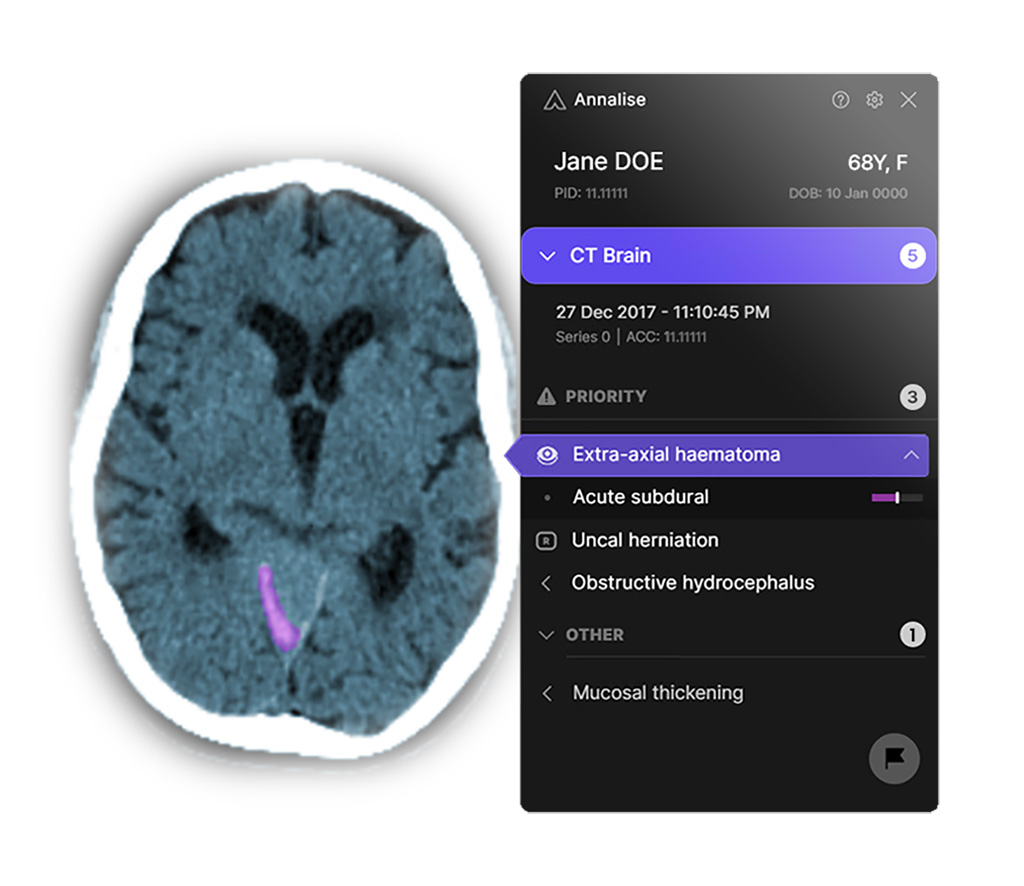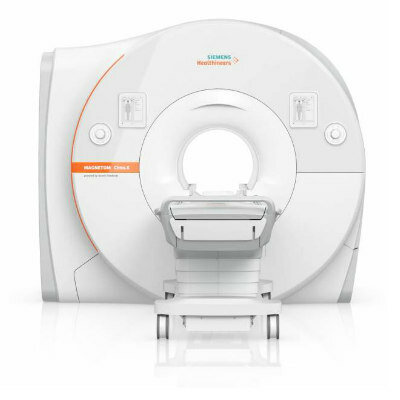Deep Learning System Boosts Radiologist Accuracy and Speed for Head CTs
|
By MedImaging International staff writers Posted on 26 Sep 2023 |

Non-contrast computed tomography of the brain (NCCTB) is a commonly employed method for identifying intracranial pathology. Despite its frequent use, the complex scan outcomes are prone to being misunderstood. Now, a deep learning system acts like a second pair of eyes for radiologists in interpreting these scans and identifies as many as 130 different findings on unenhanced CT scans of the brain in less than two minutes. This is crucial for quick diagnosis and treatment of conditions like strokes or internal bleeding in the brain that require rapid intervention.
The Annalise Enterprise CTB solution from Annalise.ai (Sydney, Australia) is a state-of-the-art radiology AI solution for non-contrast head CT studies. This AI solution is designed to quickly identify up to 130 different radiological findings on non-contrast head CT scans, including conditions that need time sensitive interventions. Now, a pioneering clinical study has demonstrated that this state-of-the-art diagnostic support technology can effectively enhance the performance levels of radiologists.
The multi-reader, multi-case study compared the effectiveness of 32 radiologists in diagnosing clinical issues on non-contrast CT brain scans. Initially, these professionals assessed the cases without the aid of the Annalise Enterprise CTB technology. After a break of at least four months, the same scans were reviewed again, but this time with the support of Annalise's technology. The findings showed that the use of Annalise Enterprise CTB significantly boosted the accuracy of detection and also sped up the interpretation process compared to when the radiologists worked unassisted.
The study demonstrated that the accuracy of radiologists improved by 32% when aided by Annalise Enterprise CTB, and the total time taken for interpretation decreased by 11%. For 91 specific findings, the system significantly increased the accuracy of radiologists, while for the rest, the results were comparable to those of the radiologists working without the Annalise solution. This implies that integrating Annalise Enterprise CTB into practice could offer several advantages, such as lowering the rate of errors, improving efficiency, and enhancing patient care by enabling faster and more accurate diagnoses.
“This important clinical study indicates that radiologist performance improves with diagnostic support from a comprehensive, multi-finding AI solution,” said Annalise Chief Medical Officer Rick Abramson. “The results have important implications for patients and clinicians. We look forward to further measuring and validating them in the clinical trials we continue to conduct around the world.”
Related Links:
Annalise.ai
Latest General/Advanced Imaging News
- CT Colonography Beats Stool DNA Testing for Colon Cancer Screening
- First-Of-Its-Kind Wearable Device Offers Revolutionary Alternative to CT Scans
- AI-Based CT Scan Analysis Predicts Early-Stage Kidney Damage Due to Cancer Treatments
- CT-Based Deep Learning-Driven Tool to Enhance Liver Cancer Diagnosis
- AI-Powered Imaging System Improves Lung Cancer Diagnosis
- AI Model Significantly Enhances Low-Dose CT Capabilities
- Ultra-Low Dose CT Aids Pneumonia Diagnosis in Immunocompromised Patients
- AI Reduces CT Lung Cancer Screening Workload by Almost 80%
- Cutting-Edge Technology Combines Light and Sound for Real-Time Stroke Monitoring
- AI System Detects Subtle Changes in Series of Medical Images Over Time
- New CT Scan Technique to Improve Prognosis and Treatments for Head and Neck Cancers
- World’s First Mobile Whole-Body CT Scanner to Provide Diagnostics at POC
- Comprehensive CT Scans Could Identify Atherosclerosis Among Lung Cancer Patients
- AI Improves Detection of Colorectal Cancer on Routine Abdominopelvic CT Scans
- Super-Resolution Technology Enhances Clinical Bone Imaging to Predict Osteoporotic Fracture Risk
- AI-Powered Abdomen Map Enables Early Cancer Detection
Channels
Radiography
view channel
AI Detects Fatty Liver Disease from Chest X-Rays
Fatty liver disease, which results from excess fat accumulation in the liver, is believed to impact approximately one in four individuals globally. If not addressed in time, it can progress to severe conditions... Read more
AI Detects Hidden Heart Disease in Existing CT Chest Scans
Coronary artery calcium (CAC) is a major indicator of cardiovascular risk, but its assessment typically requires a specialized “gated” CT scan that synchronizes with the heartbeat. In contrast, most chest... Read moreMRI
view channel
AI Model Outperforms Doctors at Identifying Patients Most At-Risk of Cardiac Arrest
Hypertrophic cardiomyopathy is one of the most common inherited heart conditions and a leading cause of sudden cardiac death in young individuals and athletes. While many patients live normal lives, some... Read more
New MRI Technique Reveals Hidden Heart Issues
Traditional exercise stress tests conducted within an MRI machine require patients to lie flat, a position that artificially improves heart function by increasing stroke volume due to gravity-driven blood... Read moreUltrasound
view channel
Wireless Chronic Pain Management Device to Reduce Need for Painkillers and Surgery
Chronic pain affects millions of people globally, often leading to long-term disability and dependence on opioid medications, which carry significant risks of side effects and addiction.... Read more
New Medical Ultrasound Imaging Technique Enables ICU Bedside Monitoring
Ultrasound computed tomography (USCT) presents a safer alternative to imaging techniques like X-ray computed tomography (commonly known as CT or “CAT” scans) because it does not produce ionizing radiation.... Read moreNuclear Medicine
view channel
Novel Bacteria-Specific PET Imaging Approach Detects Hard-To-Diagnose Lung Infections
Mycobacteroides abscessus is a rapidly growing mycobacteria that primarily affects immunocompromised patients and those with underlying lung diseases, such as cystic fibrosis or chronic obstructive pulmonary... Read more
New Imaging Approach Could Reduce Need for Biopsies to Monitor Prostate Cancer
Prostate cancer is the second leading cause of cancer-related death among men in the United States. However, the majority of older men diagnosed with prostate cancer have slow-growing, low-risk forms of... Read moreImaging IT
view channel
New Google Cloud Medical Imaging Suite Makes Imaging Healthcare Data More Accessible
Medical imaging is a critical tool used to diagnose patients, and there are billions of medical images scanned globally each year. Imaging data accounts for about 90% of all healthcare data1 and, until... Read more
Global AI in Medical Diagnostics Market to Be Driven by Demand for Image Recognition in Radiology
The global artificial intelligence (AI) in medical diagnostics market is expanding with early disease detection being one of its key applications and image recognition becoming a compelling consumer proposition... Read moreIndustry News
view channel
GE HealthCare and NVIDIA Collaboration to Reimagine Diagnostic Imaging
GE HealthCare (Chicago, IL, USA) has entered into a collaboration with NVIDIA (Santa Clara, CA, USA), expanding the existing relationship between the two companies to focus on pioneering innovation in... Read more
Patient-Specific 3D-Printed Phantoms Transform CT Imaging
New research has highlighted how anatomically precise, patient-specific 3D-printed phantoms are proving to be scalable, cost-effective, and efficient tools in the development of new CT scan algorithms... Read more
Siemens and Sectra Collaborate on Enhancing Radiology Workflows
Siemens Healthineers (Forchheim, Germany) and Sectra (Linköping, Sweden) have entered into a collaboration aimed at enhancing radiologists' diagnostic capabilities and, in turn, improving patient care... Read more

















.jpeg)



